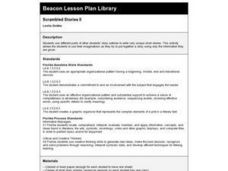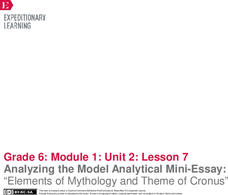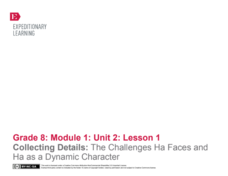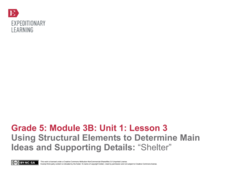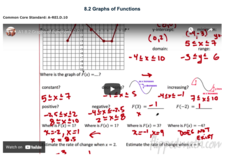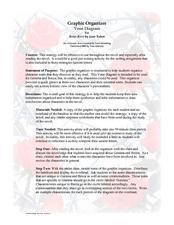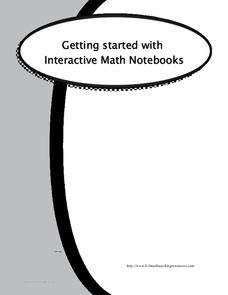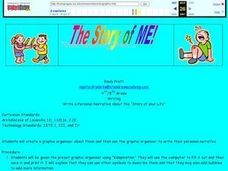Bright Hub Education
How to Outline, Plan & Write a Memoir
Get to know each individual through a memoir project. The lesson outlined here is a bit vague, but has some promising ideas for graphic organizers to help writers prepare their work. In order to succeed with the lesson, you will need to...
Curated OER
Venn Diagram for Compare/Contrast
Use this lesson to focus on a compare and contrast writing structure in your middle school language arts class. Here, young writers compare and contrast two texts using graphic organizers. They use a double bubble format for their...
Curated OER
Scrambled Stories II
Review story elements with your class. They will use examples from a story to develop critical-thinking questions. Then they use a graphic organizer to describe the setting, character, and plot of the story, focusing on how they...
EngageNY
Analyzing the Model Analytical Mini-Essay: “Elements of Mythology and Theme of Cronus”
It's time to make a claim. Scholars learn what it means to make a claim by first looking at a model analytical mini-essay to determine how the author relayed ideas. Pupils then work with partners to discuss how the author might have...
Missouri Department of Elementary
Are You Balanced?
Balance scales create a strong visual of how an individual prioritizes one's self alongside their commitments to the community, school, and home. Scholars complete a graphic organizer then discuss their findings with their peers. A...
National Park Service
Hibernation-Migration-Fascination
What's the difference between hibernation and a good nap? Find out with an engaging life science activity that compares the hibernation habits of grizzly bears and marmots. After learners read an informational passage about each mammal,...
EngageNY
Collecting Details: The Challenges Ha Faces and Ha as a Dynamic Character
What is a dynamic character? Using an interesting resource, scholars set out to answer the question. They create graphic organizers to collect details about character development as they read the novel Inside Out & Back Again. They...
New York City Department of Education
Grade 3 Literacy: Investigating Sharks
Shark! Scholars read about sharks in Facts about Sharks by Susanna Batchelor. They then pretend they are shark scientists and choose a shark they want to study. Learners research their sharks and record information in graphic organizers...
EngageNY
Using Structural Elements to Determine Main Ideas and Supporting Details: “Shelter”
Does the picture tell the story? Learners continue their work in The Inuit Thought of It by creating a visual gist of pages 16 and 17. They then complete a main idea graphic organizer and discuss key supporting details.
Newspaper Association of America
Community Connections with Geography and the Newspaper
Understanding geography and government begins at the local level. Using maps and the parts of a newspaper, a unit plan introduces the concept of community. It starts with the creation of classroom and school maps, and then moves through...
EngageNY
Building Background Knowledge: The Boy Who Invented TV, “Life before Philo”
Walk through the pictures to understand the text. Scholars analyze The Boy Who Invented TV: The Story of
Philo Farnsworth by taking a book walk and looking at the pictures. They then do a first read of Life before Philo to determine the...
Curated OER
Dr. Seuss - Make Time for Rhymes
Read the story Green Eggs and Ham to practice phonemic awareness, rhyming, and writing skills with emerging readers. They will match oral words to printed words, create a graphic organizer, and the use rhyming words in an original...
Flipped Math
Graphs of Functions
Create a graphical description. Pupils watch a video presentation starting with vocabulary on properties of a graph of a function and then use the vocabulary to find key features of graphs of a function. Scholars use three graphs in the...
Curated OER
Graphic Organizer: Venn Diagram for Briar Rose
Compare and contrast the characters of Gemma and Becca from Briar Rose. Using a Venn diagram (not included but easy to create), readers will explore the characters. Not much direction or explanation is included here.
Curated OER
Getting Started with Interactive Math Notebooks
Set young mathematicians up for success with this interactive math notebook. Including a list of rules and expectations for using the notebooks, as well as templates for a creating a cover page and table of contents, this resource...
Curated OER
CREATING A CHARACTER TRAIT MOBILE FROM THE OPERA THE LITTLE PRINCE
Students create a mobile that includes each of the six planets. They list the character traits of each of the characters from the six planets visited by the Prince. They present their project to the class and teacher.
Curated OER
A Graphic Scene
Third graders discuss the advantages of using various graphic organizers including Venn Diagrams and T-charts. They use the organizers to compare and contrast different versions of classic mythological stories.
Curated OER
The Story of Me
Students are given the preset graphic organizer using "Kidspiration". They create a graphic organizer about them and then use the graphic organizer to write their personal narrative.
EngageNY
Getting a Handle on New Transformations 2
Use 2x2 matrices to move along a line. The second day of a two-day activity is the 28th installment in a 32-part unit. Pupils work together to create and solve systems of equations that will map a transformation to a given point. The...
LABScI
Taxonomy: Who is in My family?
Find similarities in seemingly unlike organisms. The second instructional activity in a series of 12 builds the concept of a taxonomy and explores the use of a dichotomous key. Learners begin in part one by attempting to group a set of...
Classroom Adventures Program
Creating Characters
Examine character in depth. Over the course of these six lessons, learners explore their own character traits, determine the traits of characters in the books they read, practice comparing and contrasting, and collaborate in small groups...
Curated OER
How To Make an Artificial Organ
High schoolers examine the advances made in technology with regard to prosthetics and replacement organs and limbs. They describe the anatomy and functions of different organs and create their own artificial organ. They defend and...
Schoodoodle
September!
Here's a must-have resource for primary classrooms. The 144-page resource is packed with ideas, tips, suggestions, templates, worksheets, graphic organizers, and activities, all with a September theme. The calendar even notes special...
Dream of a Nation
Creating Awareness through Action Oriented Writing and Research
Middle schoolers aren't too young to feel strongly about politics, social issues, consumer rights, or environmental problems. Demonstrate the first steps toward social change with a project about action-oriented writing. Eighth graders...




